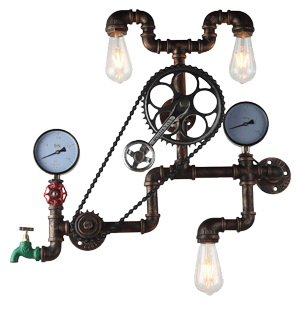About Light Covers and Shades
Regardless of if your light cover is a decorative shade or utilitarian cover, replacing a broken or missing cover is an opportunity to customize your home and add your special touch to a room. The need to replace a cover might be the only excuse you were looking for to replace the light with a more functional track lighting system or that intriguing chandelier you have been dreaming of. Understanding the how’s and why’s is the first step to determining what type of shade, cover, or replacement light you want to go with.
The How
How a light gets its electricity is the same regardless of the light type. The electricity comes to the light in a standard 14-gauge wire which can support 15 amps of power which is more than enough to power a whole room of lights. Once the wire reaches the installation location its wired into an electrical box. This box may be heavy duty metal box attached to ceiling joists for heavy chandeliers, or a light duty plastic box supported by the drywall around it for standard lighting applications. The electrical box can always be retrofit to a heavy-duty model.
The light fixture is then attached to the electrical box which will support the weight of the light fixture. Some lights are directly mounted to the ceiling or wall and support their own weight such as track lights and vanity lights. The benefit of installing lights that disperse their weight over a larger area is that there is rarely any need to upgrade the electrical box to a heavy-duty model. Since it is possible to install any type of light in any location, then why would you replace a light shade or cover?
The Why
Why light shades and covers exist is a complicated question. The utility of a light cover is easily understandable such as preventing the light from breaking or keeping the light watertight, but decorative shades have little rhyme or reason. Originally light shades were used to soften the harsh light and diffuse the light evenly into the room, but some modern “Shades” are geometric shapes with no diffusion material. In today’s modern lighting era where color changing dimmable artisan light bulbs are available, the light shade is nothing more than an aesthetic choice where form is the only consideration.
Decorative light shades can be made of wood, metal, plastic, cloth, paper, and almost any other material or object that you can think of. Depending on the design cues of the house a traditional shade may fit the space perfectly, or perhaps a modern style would be more fitting. There are hundreds of thousands of light shade options and new bespoke designs being created every day. If you want to go down a rabbit hole, I recommend looking at all the different lighting options available for you home. One additional consideration that should be made is the type of bulb being used. Overheating a light shade with an LED is unlikely, but if you are using traditional incandescent bulbs, it is possible that an inappropriately sized bulb stuffed into a tight light shade could pose a fire hazard.
When a shade is damaged or missing it can be almost impossible to find a replacement because of limited production runs, color fade over time, or scarcity. Normally when one light shade is damaged or missing, all the other light shades in the room are replaced to create a uniform design language. Most hardware stores have the most common glass, plastic, paper, and cloth light shades available for purchase. When a light shade needs to be replaced, you don’t always have to buy the same type of shade. Some lights can be easily retrofit to accept a completely different style of shade.
Utilitarian light covers are often used when a light is at risk of being damaged or located in an environment that could be dangerous. The most common type of light cover is a traditional metal or plastic cover that can be used in garages, workspaces, and attics to prevent the bulb from being broken when moving past the fixture. If a bulb were to be broken it is likely that the object or person will come in direct contact with live electrical conductors which could result in fire or electrocution. The installation of a cover may not stop the bulb from breaking in all situations, but it may prevent injury. A common example of this the use of plastic tube light covers that are used to protect people from falling glass when a fluorescent bulb is accidently struck.
Some light covers will protect the bulb from environmental factors such as water intrusion or combustible gasses. These airtight light covers are only designed to accept a specific type of bulb to ensure that the bulb and fixture don’t overheat. Most people have environmentally protected covers on their house, and they don’t even realize it.
An exterior rated light fixture is designed to protect the bulb and electrical components from environmental conditions such as rain and wind-blown snow. Using the wrong fixture could result in a fire or electrocution, so always double check that your fixture is designed to be outside. Exterior rated fixtures are normally located in their own section at the store.
Replacing a utilitarian light cover doesn’t have to result in an ugly light fixture. There are many purpose-built alternatives to ugly industrial looking lights, but as we stated earlier sometimes that industrial look may be exactly what you’re going for.
I hope this was helpful, and good luck finding the perfect light cover to match your style and needs!













